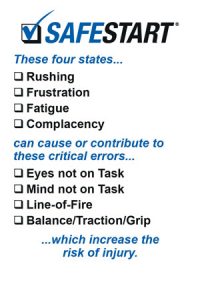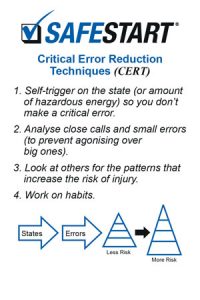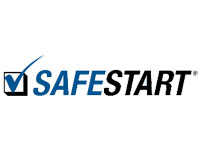Human Factors Safety (HFS) and Behaviour-Based Safety (BBS) aim to improve workplace safety, but they differ in their focus and methodology. HFS is a human-centred approach that involves personal and task analysis, training, and education. BBS involves traditional observation and feedback processes, positive reinforcement, and data analysis.
What’s the difference, and why does it matter?
Human Factors Safety is concerned with understanding and optimizing the interactions between humans and their environment to enhance safety, efficiency, and well-being.
- It’s about understanding the importance of human error and empathizing with the people elements in organizational systems.
- It considers human capabilities, limitations, and behaviours to affect organizational processes and minimize the risk of incidents.
- The human-centred design of HFS training supports and empowers workers to recognize their physical and mental states, increasing their risk exposure.
- It helps people develop skills and habits to prevent performance and injury-related errors. Individual training is highly effective for organizations endeavouring to “walk the talk” and push the needle towards an exceptional safety culture, prioritizing every human life.

Behaviour-Based Safety involves the systematic observation of workers’ behaviours in the workplace to identify safe and unsafe actions. Observers provide:
- Prompt feedback for workers on their behaviours.
- Reinforcing safe practices.
- Enhancing ergonomic working conditions.
- Suggesting improvements for unsafe practices.
Positive reinforcement and rewarding safe behaviours within BBS can promote and enhance an organization’s safety culture. Data analysis based on safety-related behavioural insights collected during observations also alerts organizations to trends, patterns, and areas of improvement to inform systemic interventions.
The problem we all face:
Nobody intentionally makes mistakes, and the age-old problem challenging every safety professional is: how do we stop people from making mistakes?
Four human factors are responsible for most of the performance and injury-related errors people make. These human factors are physical and mental states that affect everyone – rushing, frustration, fatigue, and complacency. While these four states do not encompass all human elements or conditions, they are the most prevalent in everyday life.
The critical errors that result from being in one or more of these states include:
- Not having your eyes on task (focus).
- Not having your mind on task (concentration).
- Moving into or being in the line of fire.
- Experiencing problems with balance, traction, and grip.
Balance, traction, and grip errors are often called slips, trips, and falls. However, grip errors also include dropping something or skidding and losing control.
The four states (human factors) cause or contribute to critical errors, which elevate the risk of any task. This state-to-error pattern is present in over 95% of all acute injuries. It’s hard to think of a time you’ve been hurt when you weren’t in one or more of those states before an incident occurred.
The solution:
Both BBS and HFS support safer work practices and injury prevention; however, HFS is more effective at helping individuals to prevent the mistakes and errors they never intended to make in the first place.
The Critical Error Reduction Techniques prevent injuries caused by rushing, frustration, fatigue, and complacency. In SafeStart’s human factors safety training, each person increases their awareness of those four states and develops skills and habits to prevent mistakes and errors caused by human factors on an individual level.

So, how do you choose HFS or BBS?
Choosing HFS or BBS is difficult because both approaches can improve safety and performance. However, one problem with only using BBS observations is that people behave differently than they would usually when they know they’re being watched. If a supervisor or manager conducts an undetected observation, it mitigates the risk of observing unnatural behaviour. However, BBS best practices encourage open communication, and supervisors typically let their employees know they are conducting a behavioural safety observation. As a result, observers rarely witness authentic employee behaviour, skewing or twisting the data collected. Additionally, when the person conducting the behavioural observation is absent, workers usually revert to habitual behaviours that can inadvertently increase the risk of injury. Additionally, BBS has been called “sterile” by employee groups because it doesn’t create an emotional connection to employees’ families or 24/7 safety at work, at home, and on the road. On the other hand, HFS training is designed to create sustainable skills and habits for individuals that work 24/7 (whether they’re being observed or not). The prolonged positive effects of HFS persist because the person autonomously shifts their behaviour armed with knowledge and awareness. Understanding the consequences of neglecting human factors and consciously incorporating new behaviours into regular work processes creates lasting results that enhance organizational performance and injury reduction.
In summary
HFS training focuses on designing behaviour and processes to match human capabilities, while BBS concentrates on influencing individual behaviour in a structured observation and feedback process. The big difference is that HFS skills work to reduce the risk of injury 24 hours per day, seven days per week, and transcend the boundaries of the workplace to include driving safety and safety at home. The behavioural shift isn’t limited to the BBS observation and feedback period or the workday. Therefore, implementing HFS training delivers impressive results by protecting your organization’s blind spots. Combining HFS with BBS feedback processes involving human factors will take your organization to the next level.

You must reach everyone:
If HFS and BBS only focused on improving organizational efficiency, it wouldn’t matter if you didn’t reach everyone at your company. However, if you don’t train every employee with your safety initiatives, the individual who gets missed in HFS classroom training or the BBS observation and feedback process could be the individual who experiences an injury (or worse). Additionally, it might be an office or administrative team member who has an incident, and they rarely receive feedback from BBS observations. So, arming each employee with better HFS skills, habits, and Critical Error Reduction Techniques helps organizations achieve exceptional results and a tremendous culture of care.
History:

Larry Wilson is the author and founder of SafeStart, a Human Factors training program currently used by over 4.5 million people in 75 countries, approximately 10,000 worksites and is available in 32 languages. SafeStart’s inception occurred when Larry was conducting traditional BBS observations in the field 25 years ago. He boiled down the problem practically and developed techniques that work to stop people from getting hurt or making other costly errors. Preventing human error with critical error reduction techniques was and remains the missing piece for most companies.
Author:

Mike Shaw is a human factors safety consultant with ten years in the field. Before working in workplace safety, he was the head coach for the Canadian Olympic Development Ski Team, responsible for producing Olympians and Olympic Medalists. He is a performance and injury-prevention expert, author, and unforgettable keynote speaker. His informed perspective on risk and human error stems from a workplace injury in 2013 which nearly left him paralyzed from the neck down. He takes his teachings to the world with SafeStart and has worked with companies on four continents and dozens of countries. Find his book, Never Part of The Plan – A Story of Courage, Resilience, and Gratitude, on Amazon.

For more information
Location: https://g.page/SafeStart-International?share
Tel : +91 44 42321920
Mail: asia@ssi.safestart.com /
Web: http://asia.safestart.com


